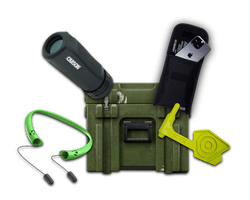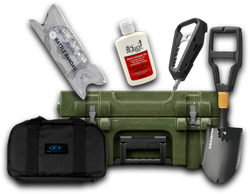
How to treat infection in the wild?
Carrying a first-aid kit is essential whenever going in the wild. When in the wild, it gets very difficult to restock these kits. In such situations, the chances of infections increase if you don't know how to use the resources you have. What most people don't know is that they have a lot of items surrounding them that could work as a treatment for the infection.
How to clean wounds to treat an infection in the wild
Clean it first whenever you get a cut or scuff on any part of the body. Cleanliness is one of the most effective things that can prevent infections and help in treatment. Without cleanliness, an infection can turn a simple scuff into something worse.
1. Wash the wound to promote healing.
Immediately washing the wound thoroughly by finding a clean water source is essential, and it would be best if you carry some distilled water with you. If you don't have water, get some fresh water in a Ziploc bag. Pole a hole in one corner or cut off a little to create a pressurized stream of water. Wash your wound with that, and make sure not to scrub it.
2. What to do if you don’t find any clean water?
You can use fresh urine if you don't find any clean water sources. It is sterile but does not contain any disinfecting properties. So, it can be good for cleaning the wound, but you still may need some disinfectants.
3. If there is still something left, remove it with tweezers.
Sometimes washing would not clean the wound completely when there are large particles in a wound. Getting debris or grass is common when you get a cut in the wild, which can be removed with tweezers.
Carefully remove any particles you see and wash the wound afterward. If you don't have any tweezers, you may use a matchstick, toothpick, or tiny stick from some plant nearby as long as it is clean.
How to prevent your wounds from the infection
Now that you know how to use the available resources to keep the wounds clean, here are some tips for disinfecting the wound.
1. Use honey as a natural disinfectant.
Finding honey in the wild is possible because, with a variety of flowers, honeybees may make their hive in the wild. So, if you ever get a wound in the wild and have no disinfectants available, look for hives of honeybees and try to harvest some honey without getting stung by those bees. Once you have honey, you can preserve it and use it for as long as you need.
2. Aloe vera gel’s antimicrobial properties can help.
Aloe Vera is an evergreen plant in semi-tropical, tropical, and even arid climates. Its gel is great for treating skin conditions, including:
- Burns
- Rashes
- Blisters
- Cuts
- Wounds, etc.
It is because it has both anti-inflammatory and antimicrobial properties. Using Aloe vera gel on your wounds will also increase tissue healing speed.
3. Pine sap is another natural antiseptic.
Pine sap is a natural antiseptic that, if found easily, will help a lot. To find this sap, you need to look for pimple-like lumps on the trees that can be popped to get this sap. Collect it in a container and boil it until it kills any germs. Applying pine sap is also simple because its consistency is like honey, so it stays on the wound when applied.
4. The cactus bandage helps heal wounds.
If you find any prickly pear cactus nearby, you can make bandages with antiseptic and astringent properties. Although it is only found in the desert, you can take one of its pads and peel it. The raw flesh inside is what's going to provide you the healing properties. Put it on the wound and secure it with a bandage for better healing.
5. Superglue works as stitches to keep the wound shut.
If you don’t find any bandage to keep the wound shut, try Superglue if it is available. First, you need something to clean and disinfect the wound, then hold the edges of the wound firmly together and put some drops of Superglue in about a 5mm radius around the wound. Let it dry, and then you may stop holding the wound. Superglue will keep the wound shut and prevent infections while improving healing.
6. Remove clothing from the wound as it may cause infection.
You don't want any clothing around the wound as it can cause infections. So, remove any clothes from around the wound and let it heal without germs surrounding it.
Dress and bandage regularly with proper care
Most wounds in the wild do not require on-time treatment. A regular dressing is essential, so you need to keep your wound clean using the cleanest water available. After you clean the wound, look for any debris left in it, and then use disinfectants. Anything with antimicrobial properties will be good enough to keep your wound safe from infections. However, there is a little more that you need to do, including:
1. Keep yourself hydrated.
Staying hydrated is very important when you want your wounds to heal quickly. Hydration helps keep the skin moist internally and from outside as well. The wounds can fill and heal quickly with better elasticity compared to dehydrated skin.
2. Continue the treatment unless you see all the signs of infections disappearing.
Lastly, you must repeat this care routine unless the wound is completely filling in. Scab formation is one of the signs that the wound is good because this thick protective crust will keep germs out as long as you do not peel it away. For added safety, you may keep following the treatment routine until new skin is formed there because it is a sign of complete healing of the wound.
Final Words
If your first aid kit is unavailable because of being completely used in the wild or you lost it on the way, then treating a wound and preventing it from infections may not seem easy. So, you must ensure 100% utilization of any resources you find in the wild for cleaning the wound, disinfecting it, and covering it up with a bandage. Once you know your resources, treating an infection in the wild will become much easier.
Image by Steve Buissinne from Pixabay
Share this article








